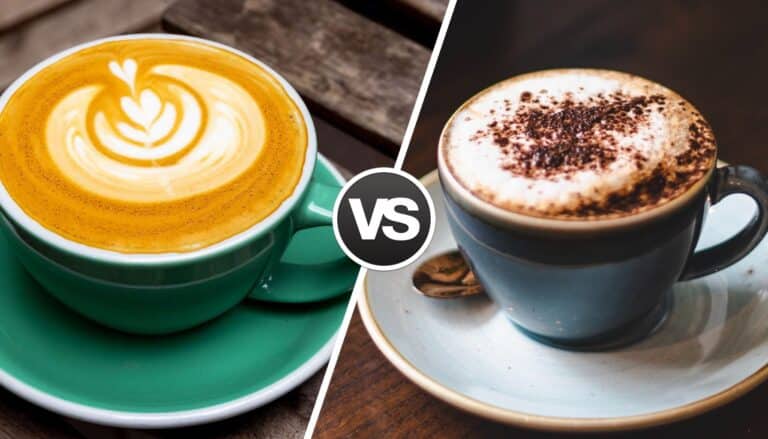Roasters transform green, raw coffee beans into the aromatic, flavorful ones we love by roasting them. This art and science involves carefully applying heat to coffee beans to unlock their complex flavors. This process changes the bean’s color, size, and density and develops its taste. The roast level, determined by how long and at what temperature the beans roast, ranges from light to dark. Each level offers a unique taste, aroma, and acidity.
At the dark end of the roast spectrum, you find dark roast coffee. It has dark brown or almost black beans that look shiny and oily. This coffee brings a bold, rich, and robust flavor with smoky or chocolatey hints. The intense flavors from roasting often overshadow the bean’s original characteristics. Despite its strong flavor, dark roast coffee has less caffeine than lighter roasts because of the longer roasting time.
Many coffee lovers enjoy the bold, full-bodied taste of dark roast coffee. It’s a key ingredient in espresso blends and is popular in Europe and North America for its hearty, comforting qualities. However, there are several myths about dark roast coffee. Some people think it’s more bitter and acidic or has more caffeine because of its intense flavor. Another myth is that all dark roasts taste the same, ignoring the subtle differences that various beans and roasting techniques can create.
To truly understand dark roast coffee, we need to clear up these myths and recognize the depth and variety it offers. With its unique roasting process and health benefits, dark roast coffee is a diverse and flavorful category worth exploring beyond its bold taste.
What is a Dark Roast Coffee?
Dark roast coffee refers to coffee beans that have been roasted for a longer period of time compared to light or Medium Roasts. This roasting process results in beans that are darker in color, often a deep brown or almost black, with a shiny surface due to the oils that are brought to the surface during roasting. The flavor profile of dark roast coffee is typically bold and rich, with a pronounced bitterness that overshadows the original flavors of the bean.
Understanding Coffee Roasting
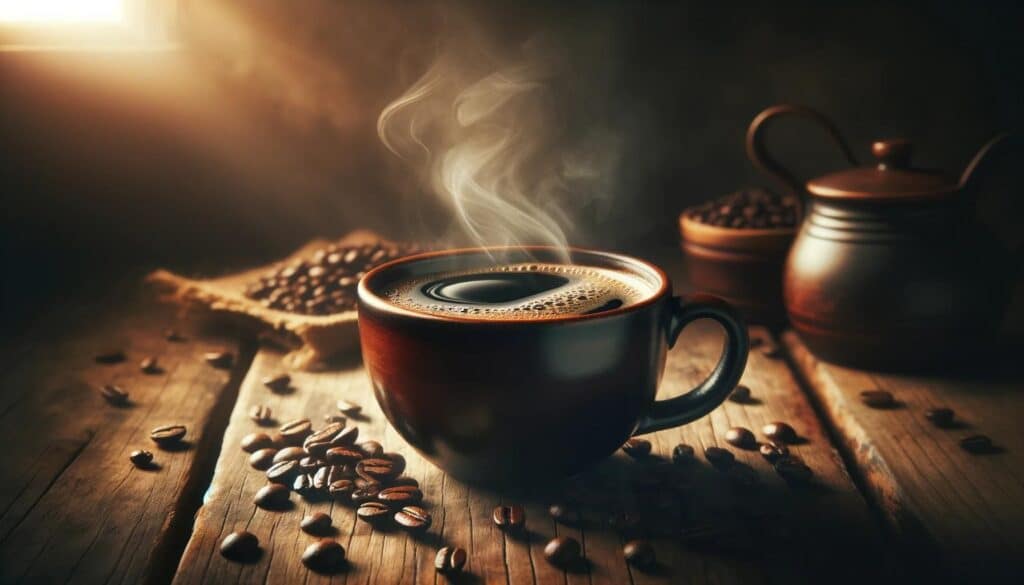
Let’s talk about how we roast coffee and why it’s so important for making your coffee taste great. Roasting coffee is a big deal because it changes the flavor, smell, and feel of the coffee you drink. It’s about heating up green coffee beans until they turn into the roasted beans we grind and brew.
Explanation of the Coffee Roasting Process
Roasting coffee is like being both an artist and a scientist. You need to be precise and pay close attention. We start with green, unroasted beans that don’t yet have the rich flavors and smells of coffee. We roast these beans at temperatures between 356°F and 464°F. During roasting, the beans go through a bunch of chemical changes.
One key change is the Maillard reaction, which is also what makes toasted bread and seared meat taste good. This reaction between amino acids and sugars in the beans brings out the complex flavors and aromas of coffee. While roasting, the beans lose water, get bigger, and change in how heavy and what color they are. Depending on how dark we want the roast, this can take anywhere from a few minutes to more than half an hour.
Stages of Coffee Roasting: Light, Medium, and Dark
- Light Roast: Beans are roasted until just after the first crack, a popping sound that occurs as the beans expand and crack open. Light roasts have a light brown color, no oil on the surface, and retain most of the original flavors of the coffee bean, accentuating its natural acidity.
- Medium Roast: This level reaches just before or right after the second crack. Beans take on a medium brown color, and the roasting process begins to balance acidity with the bean’s inherent flavors, introducing more body and a fuller taste.
- Dark Roast: Dark roasted beans are cooked longer, often until the second crack or beyond. The beans turn dark brown or nearly black, with an oily surface. This roast level emphasizes rich, bold flavors with lower acidity, highlighting roasty notes and often chocolate or smoky undertones.
The Impact of Roasting on Flavor Profiles
The roast level has a profound impact on the coffee’s final taste. Light roasts can preserve unique varietal flavors of the coffee bean, often resulting in a brighter, more acidic brew that highlights floral, fruit, or berry notes. Medium roasts offer a more balanced flavor, acidity, and body, making them widely appealing with a broader range of taste sensations. Dark roasts provide a strong, bold flavor profile, reducing the bean’s original flavors in favor of the rich, smoky, or chocolatey notes developed during roasting.
Each stage of roasting brings out different flavors and characteristics from the coffee beans, allowing roasters to create blends that appeal to various palates. Understanding these stages helps consumers choose coffee that best suits their flavor preferences, enhancing their coffee experience.
The Characteristics of Dark Roast Coffee
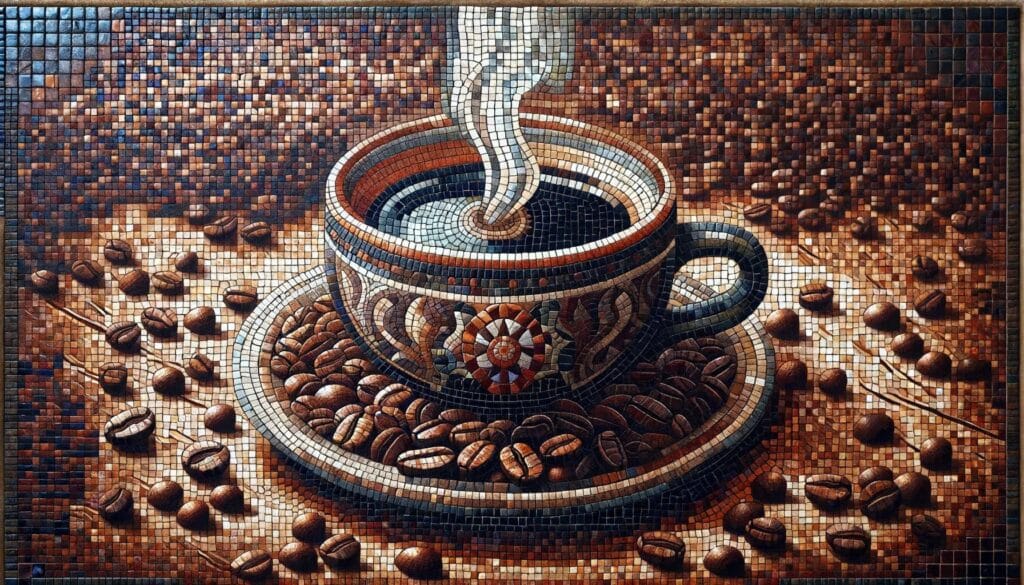
Dark roast coffee is renowned for its bold flavor and rich, robust character, setting it apart from its lighter roast counterparts. The distinctive qualities of dark roast coffee encompass its appearance, flavor profile, and the various names and varieties it comes in. Understanding these characteristics can enhance appreciation for this popular coffee roast level.
Description of Bean Appearance and Color
Dark roast coffee beans are notable for their dark brown to nearly black color, a result of the extended roasting process. These beans are often shiny due to the oil that surfaces on the bean during the roasting. This oiliness is a key visual indicator of a dark roast. In terms of size, the beans expand during roasting, but they become denser and heavier than lighter roasts. The roasting also leads to a smoother bean surface compared to the wrinkled surface of lighter roasts, as the beans lose more moisture and develop more cracks if taken to the very dark end of the spectrum.
Flavor Profile: Bold, Smoky, and Less Acidic
The flavor profile of dark roast coffee is markedly bold and intense. The extended roasting time breaks down the acids in the beans, resulting in a cup of coffee that is less acidic and smoother on the palate. These coffees often have a pronounced bitterness that is appreciated by those who prefer a hearty, strong cup of coffee. The flavors are rich, with smoky, chocolatey, or even burnt undertones, which can overshadow the original flavors of the bean. Despite a common misconception, dark roast coffee can have less caffeine than lighter roasts due to the degradation of caffeine molecules at higher roasting temperatures.
Common Names and Varieties
Dark roast coffee comes in several varieties, each with its unique profile and roasting degree. Some of the most common names include:
- French Roast: Known for its nearly black beans, French Roast is one of the darkest roasts available. It has a smoky-sweet flavor with low acidity and a thin body, making it ideal for those who enjoy a deep, intense coffee taste.
- Italian Roast: Slightly lighter than French Roast, Italian Roast coffee is dark brown in color and has a glossy oil sheen. It is often used for espresso due to its bold flavor and the creamy consistency it lends to espresso shots.
- Espresso Roast: Though not exclusively dark, espresso roasts are often on the darker side to achieve the rich, concentrated flavor desired in espresso. This roast is optimized for espresso brewing, offering a balanced, robust flavor.
Each of these dark roast varieties presents a unique tasting experience, catering to different preferences within the spectrum of dark roast lovers. From the bold, smoky nuances of a French Roast to the rich, concentrated essence of an Espresso Roast, dark roast coffee encapsulates a world of deep flavors and aromatic complexity.
How Dark Roast Coffee is Made

The creation of dark roast coffee involves careful control of roasting temperature and time to achieve its signature bold, rich flavor. This process not only changes the physical appearance of the coffee beans but also induces significant chemical transformations. Understanding these factors helps in appreciating the depth and complexity of dark roast coffee.
Roasting Temperature and Time
Dark roast coffee requires a higher temperature and longer roasting time compared to lighter roasts. Typically, the roasting temperature for dark roasts ranges from 230°C to 250°C (446°F to 482°F). The beans are roasted until they reach the second crack, which is a louder, more intense cracking sound compared to the first. This second crack signifies a further development in the roasting process, where the beans have expanded further and the cell walls are breaking down at a greater rate. The total roasting time can vary but generally falls between 12 to 17 minutes, depending on the desired darkness and the specific characteristics of the bean.
The Chemical Changes in Beans During Dark Roasting
As coffee beans are subjected to high temperatures, several key chemical reactions occur:
- Maillard Reaction: This reaction between amino acids and reducing sugars forms complex flavors and brown pigments, contributing to the coffee’s rich taste and dark color.
- Caramelization: Sugars within the beans begin to caramelize, adding to the sweetness and complexity of the flavor, though in dark roasts, this is often a more bitter sweetness due to the intensity of the heat.
- Degassing: Dark roasted beans release carbon dioxide more rapidly, which can affect the freshness and flavor profile of the coffee.
- Reduction in Acidity: The longer roasting process breaks down more of the acidic compounds in coffee beans, resulting in a smoother, less acidic cup.
Comparison with Lighter Roasts in Terms of Roasting Process
Compared to dark roasts, lighter roasts are subjected to lower temperatures and shorter roasting times. Light roasts might be roasted at temperatures from 180°C to 205°C (356°F to 401°F) and are often stopped just after the first crack, which occurs around 196°C to 205°C (385°F to 401°F). This shorter roasting period preserves more of the bean’s original flavors and acidity, resulting in a brighter, more nuanced cup with higher levels of caffeine since less is burnt off during roasting.
In contrast, dark roasts undergo a more extensive roasting process, which emphasizes the roast character over the bean’s inherent qualities. This results in the bold, smoky flavors characteristic of dark roast coffee. The chemical changes are more pronounced in dark roasts, leading to a decrease in acidity and an increase in bitterness, which is often associated with the deep, rich flavors of dark roast coffee.
Understanding these differences highlights the importance of the roasting process in shaping the coffee’s final taste profile, allowing for a wide range of coffee experiences from a single bean origin based on roast level.
Health Benefits and Misconceptions of Dark Roast Coffee
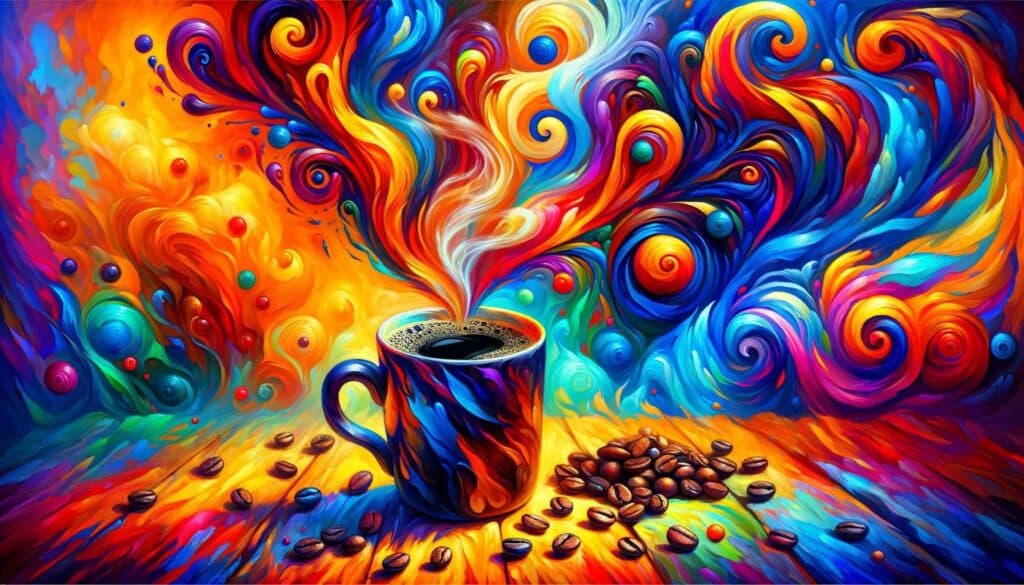
Dark roast coffee, with its bold flavor and rich aroma, is often surrounded by myths and misconceptions, especially regarding its caffeine content, health benefits, and taste profile. Understanding the truths behind these misconceptions can enhance appreciation for dark roast coffee and inform healthier consumption choices.
Addressing Myths about Caffeine Content in Dark vs. Light Roasts
One of the most common myths is that dark roast coffee contains more caffeine than light roast coffee due to its stronger flavor. However, the truth is somewhat more complex. The caffeine content in coffee can be affected by various factors, including the type of coffee bean, the brewing method, and, to a lesser extent, the roast level. While roasting does affect caffeine concentration, the difference is minimal. In reality, light roasts may retain slightly more caffeine because caffeine slightly degrades at the higher temperatures used for dark roasting. However, because dark roasted beans lose more moisture and become lighter, if you measure your coffee by scoops (volume), dark roasts could end up delivering more caffeine. If measured by weight, the difference is negligible.
Potential Health Benefits of Dark Roast Coffee
Dark roast coffee is not just about intense flavor; it also offers several health benefits, similar to coffee in general, but with some unique advantages:
- Antioxidants: Dark roast coffee is rich in antioxidants, which help combat oxidative stress and reduce the risk of diseases, including certain cancers and heart disease.
- Reduced Stomach Acid: The N-methylpyridinium (NMP) created during dark roasting can make dark roast coffee easier on the stomach than lighter roasts by reducing the secretion of stomach acid.
- Neuroprotective Benefits: Studies have suggested that a compound formed during the dark roasting process may help protect brain cells and lower the risk of neurodegenerative diseases like Alzheimer’s and Parkinson’s.
Debunking Common Misconceptions about Bitterness and Strength
The perception that dark roast coffee is inherently bitter and stronger in terms of caffeine content is another widespread misconception. While dark roast coffee does have a bold, robust flavor profile, attributing this solely to bitterness oversimplifies the taste. The roasting process develops a rich palette of flavors, including sweetness from caramelized sugars, which can balance the bitterness.
The misconception about strength also needs clarification. The term “strength” in coffee usually refers to the ratio of coffee to water, not the roast level. A dark roast coffee is not stronger in caffeine content by default; it’s the brewing method and coffee-to-water ratio that determine the strength of your cup.
In summary, dark roast coffee offers a unique blend of bold flavors and potential health benefits, with many misconceptions about its caffeine content and flavor profile needing clarification. Appreciating dark roast coffee’s complexity can lead to a more informed and enjoyable coffee experience, debunking myths and highlighting its rightful place in a healthy lifestyle.
Brewing the Perfect Cup of Dark Roast Coffee
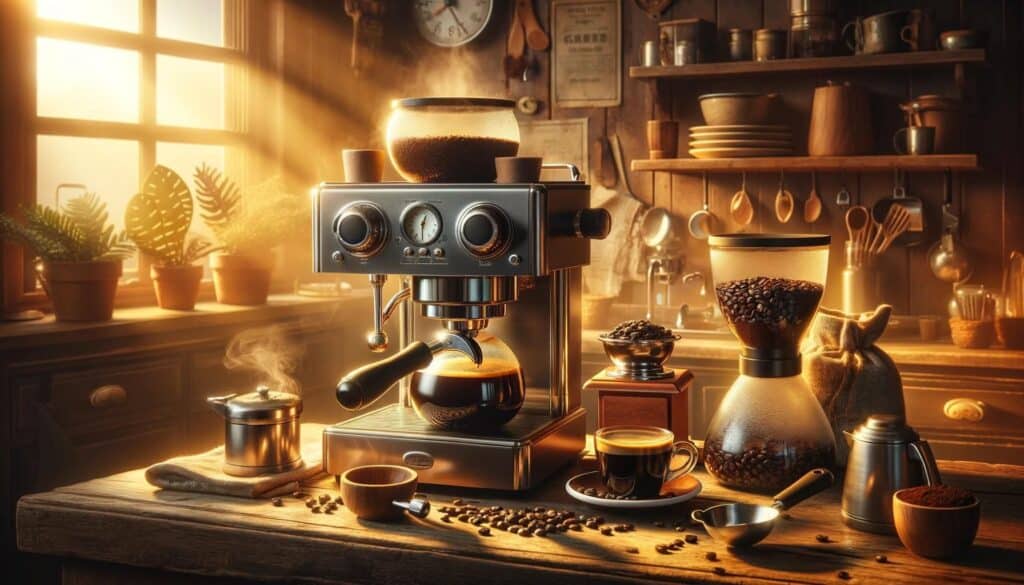
Achieving the perfect cup of dark roast coffee involves more than just selecting the highest quality beans; it’s about understanding how different brewing methods, grind sizes, and brewing parameters can affect the final taste. Here are insights into how to brew dark roast coffee to preserve its unique characteristics and ensure a rich, satisfying cup every time.
Recommended Brewing Methods for Dark Roast Coffee
- French Press: The French Press method is ideal for dark roast coffee due to its full immersion brewing, which allows the water and coffee to mingle closely, extracting the deep, rich flavors characteristic of dark roasts. The result is a full-bodied and complex cup.
- Espresso: Espresso brewing is particularly suited for dark roasts, emphasizing their bold flavors and creating a rich, creamy texture. The high pressure of an espresso machine extracts the intense flavors and aromatic oils efficiently.
- Pour-Over: While typically associated with lighter roasts, pour-over can also suit dark roasts by allowing more control over the brewing process. Using a slightly coarser grind and a slower pour can prevent over-extraction, balancing the boldness with smoothness.
How Grind Size Affects the Flavor
The grind size plays a critical role in the brewing process, affecting the extraction rate and, consequently, the taste of the coffee:
- Coarse Grinds: Best for French Press and some pour-over methods, coarse grinds allow for slower extraction, reducing bitterness and enhancing the smooth, rich flavors of dark roasts.
- Fine Grinds: Ideal for espresso, fine grinds ensure a quick, intense extraction, necessary for capturing the bold and complex characteristics of dark roast coffee in a concentrated form.
Selecting the right grind size for your brewing method is crucial in achieving the desired balance of flavors.
Tips for Preserving the Unique Characteristics of Dark Roast Coffee
- Water Quality: Use filtered or bottled water to avoid any unwanted flavors from tap water that can overshadow the coffee’s richness.
- Correct Water Temperature: Aim for a brewing temperature between 195°F and 205°F. Water that’s too hot can over-extract, leading to bitterness.
- Proper Storage: Keep your dark roast coffee beans in an airtight container away from light, moisture, and heat to preserve their freshness and flavor.
- Freshness: Grind coffee beans just before brewing. Coffee begins to lose its flavor shortly after grinding, so fresh grinding ensures the most flavorful cup.
- Experiment with Ratios: Start with a coffee-to-water ratio of about 1:16 (1 gram of coffee to 16 milliliters of water) and adjust according to taste. Dark roasts may benefit from slight adjustments to this ratio to achieve the perfect balance.
By understanding and applying these brewing principles and tips, you can enhance your coffee experience, allowing the distinctive qualities of dark roast coffee to shine through. Whether you prefer the rich intensity of an espresso or the nuanced complexity of a French Press brew, mastering these elements can lead to the perfect cup of dark roast coffee every time.
Pairing Dark Roast Coffee with Food
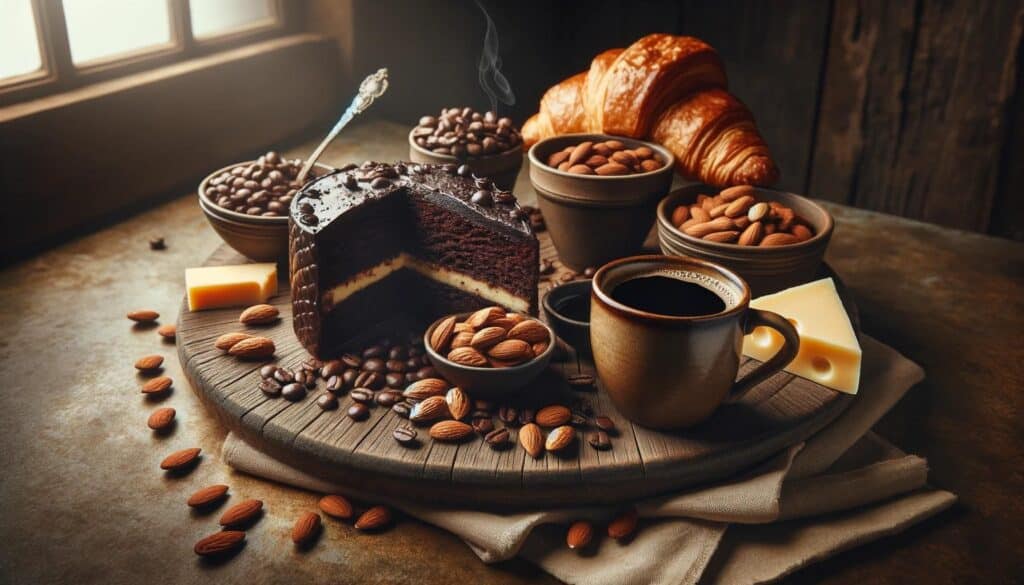
Dark roast coffee, known for its bold and robust flavors, pairs wonderfully with a variety of foods. Its rich taste can complement, contrast, or enhance the flavors of breakfast items, desserts, and snacks. Here are some pairing suggestions that can elevate your culinary experience.
Breakfast Items
- Buttery Croissants: The buttery, flaky texture and slight sweetness of croissants complement the boldness of dark roast coffee, balancing its intensity.
- Bacon and Eggs: The rich, smoky flavors of dark roast coffee match well with the savory, salty taste of bacon and the creaminess of eggs.
- Blueberry Pancakes: The tartness of the blueberries and the sweetness of the syrup provide a delightful contrast to the deep, smoky notes of the coffee.
Desserts
- Chocolate Cake or Brownies: Dark chocolate’s bitterness and richness pair excellently with dark roast coffee, enhancing its chocolatey notes.
- Tiramisu: This classic Italian dessert with its layers of coffee-soaked ladyfingers, mascarpone cheese, and cocoa powder, naturally complements the flavors of a dark roast, especially if the coffee itself is used in the recipe.
- Cheesecake: The creamy, tangy profile of cheesecake can soften the boldness of dark roast coffee, creating a harmonious balance between the two.
Snacks
- Nuts (Almonds, Walnuts): The earthy, sometimes sweet flavors of nuts can complement the deep flavors of dark roast coffee, especially when the nuts are lightly salted or caramelized.
- Dark Chocolate: Just as with desserts, a piece of dark chocolate alongside dark roast coffee can heighten the experience, as both share bitter and complex flavor profiles.
- Aged Cheeses: The sharpness and depth of aged cheeses, such as cheddar or gouda, can stand up to the intensity of dark roast coffee, making for a rich and satisfying pairing.
How Dark Roast Complements Certain Flavors and Textures
Dark roast coffee, with its bold, often smoky and slightly bitter taste profile, pairs best with foods that have a pronounced flavor. It can complement the richness of chocolate, the creaminess of dairy, the sweetness of certain fruits, or the savory depth of meat and eggs. The key is to balance the intensity of the coffee with the food’s flavors—rich and bold with similarly strong flavors, or providing a contrasting taste experience with sweeter, milder, or tangier foods.
The texture also plays a role in pairing. The smooth, sometimes oily texture of dark roast coffee can be a pleasant contrast to the flaky, buttery texture of pastries or the dense, moist texture of chocolate cake. In each case, the coffee not only adds to the flavor experience but also to the sensory enjoyment of the meal or snack, enhancing the overall dining experience.
Experimenting with different pairings can reveal surprising and delightful combinations, making each cup of dark roast coffee and accompanying food a unique discovery.
Conclusion: Celebrating the Distinctiveness of Dark Roast Coffee
Dark roast coffee shines in the coffee world with its bold flavors and rich aromas. Dark brown, almost black beans that are shiny and oily define it. It tastes less acidic but brings out a stronger bitterness, with hints of smoke, chocolate, or even a burnt flavor. This unique taste comes from roasting the beans longer, changing their look and creating deep chemical changes that boost the coffee’s richness and complexity.
Roasting dark roast coffee from bean to cup combines art and science. It requires precise control over the temperature and time of roasting to get that signature bold flavor. This coffee goes well with many foods, from savory breakfast dishes to sweet desserts, and can hold its own against strong, tasty snacks.
As you dive into dark roast coffee, you’ll find different types, such as French Roast, Italian Roast, and Espresso Roast. Each type offers a special taste for different dark roast fans. Playing with brewing methods, grind sizes, and the ratio of coffee to water can make you appreciate this kind of coffee even more, helping you make the perfect cup for your taste.
In summary, dark roast coffee isn’t just a drink; it’s an experience full of rich flavors and aromas. It invites coffee lovers to explore and enjoy the unique qualities of each cup. Whether you’ve always loved dark roast or are just starting to explore it, getting to know its diverse profiles and complex flavors can make your coffee journey more exciting and fulfilling. So, step into the bold world of dark roast coffee and find the deep joys it offers.

